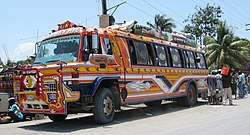
Tap taps (Haitian Creole : Taptap, pronounced [taptap] ) are gaily painted buses [1] or pick-up trucks with metal covers [2] that serve as share taxis in Haiti. They may also be referred to as camionettes. [3]
Contents
Literally meaning "quick quick", [4] these vehicles for hire are privately owned and ornately decorated. [1] They follow fixed routes, won't leave until filled with passengers, and riders can disembark at any point in the journey. [5]

